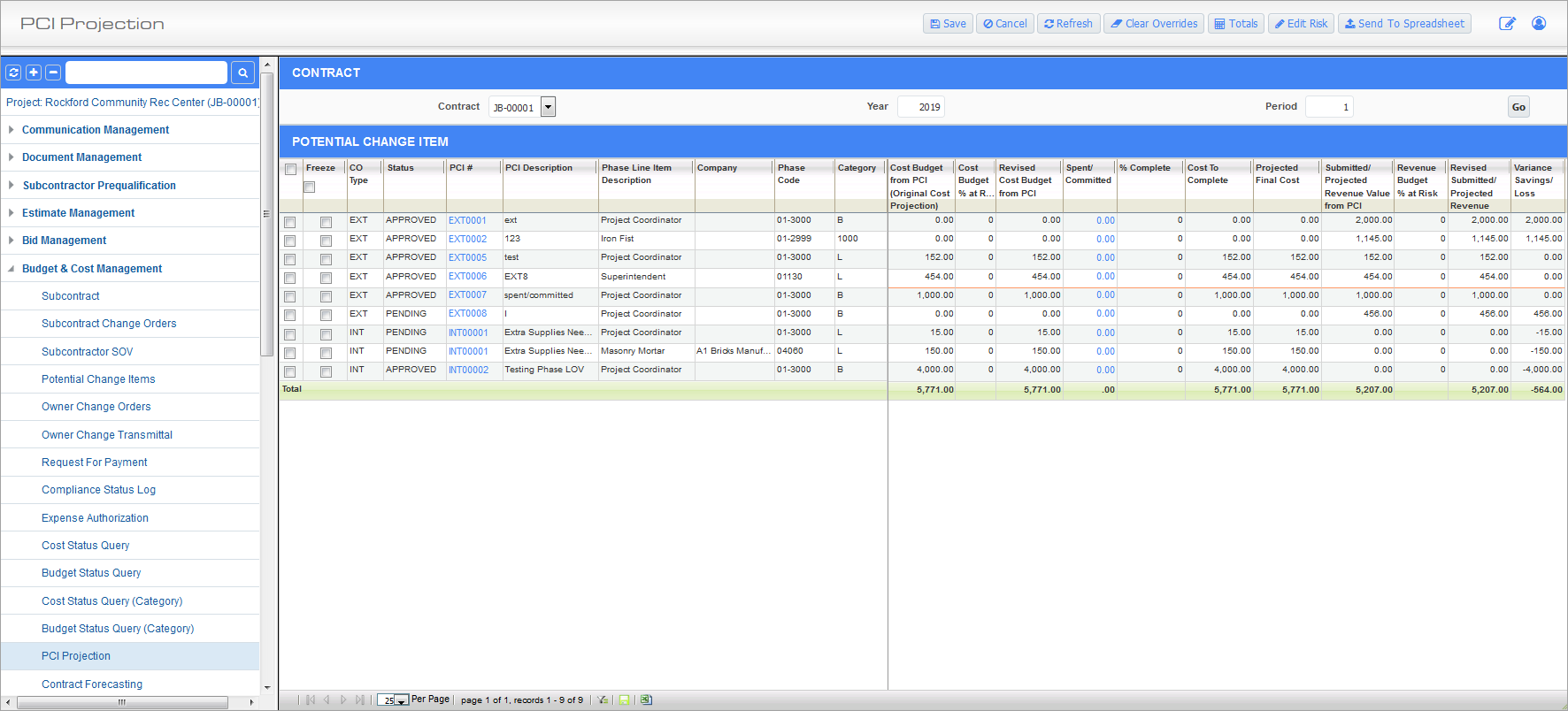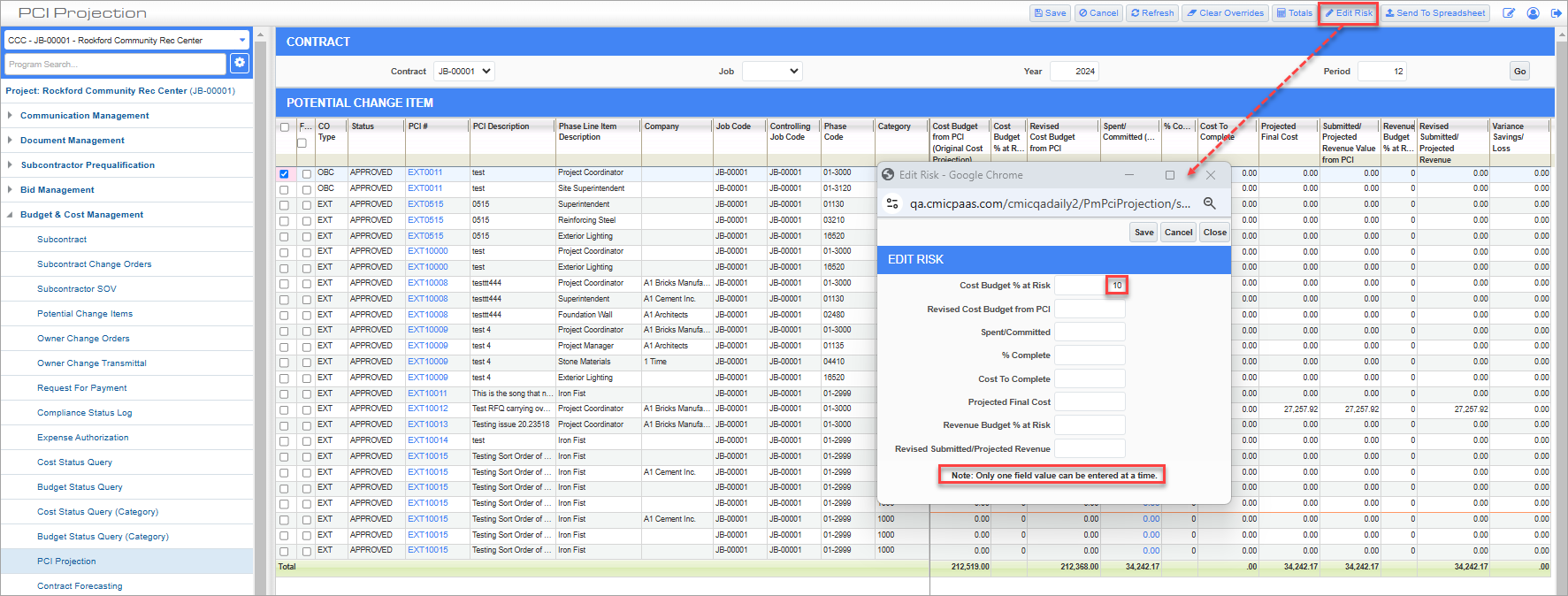
PCI Projection; standard Treeview path: CMiC Field > Budget & Cost Management > PCI Projection
The PCI Projection screen can be accessed from CMiC Field’s Treeview as a standalone program or from the Contract Forecasting with PCI Projections screen using the drill-downs on PCIs.
The PCI Projection screen deals with unposted PCIs, on which work may have already commenced and therefore incurred cost and may be subjected to cost and/or revenue risks. It may be important to recognize risks on unposted PCIs at an early stage by projecting and forecasting the amounts accordingly.
This screen allows users to apply risk on cost and revenue budget amounts and project cost and revenue amounts, which in turn will affect the contract forecasting key columns such as Projected Cost Budget, Projected Cost Forecast, Projected Bill Budget, Pending CO (Revenue side), Revenue, and Projected Profit.
Main Toolbar Buttons

The PCI Projections toolbar provides several program-specific functional buttons, as well as standard icons such as the Screen Editor, User Profile, and Help icons.
[Save] – Button
When overrides are entered, the [Save] button stores the PCI projections for the specified period.
[Cancel] – Button
The [Cancel] button cancels any unsaved changes and refreshes the screen with the previously stored values.
[Refresh] – Button
The [Refresh] button refreshes the screen by updating the PCI details according to the current status, by adding new PCIs or removing the existing ones. In either case, the stored overrides on existing lines will be preserved.
[Clear Overrides] – Button
The [Clear Overrides] button will clear all user overrides and refresh to the system-defined values.
[Totals] – Button
The [Totals] button opens a pop-up screen and displays summary totals for each PCI# projected during the period.
[Edit Risk] – Button

Edit Risk pop-up window launched from [Edit Risk] button on PCI Projection screen
The [Edit Risk] button launches a pop-up window which allows users to enter a value in one of the pop-up window’s fields and apply the override to the selected records at once, eliminating the need to apply the override on each PCI detail line. Only one value can be updated and saved at a time.
NOTE: Users must select the records to which the override will apply before clicking on the [Edit Risk] button.
[Send To Spreadsheet] – Button
The [Send to Spreadsheet] button exports the projections in a specific period into a text file.
Users may apply filters to restrict the detailed records and, if so, the export will be limited to only those visible on the screen.
Contract (Header)
The PCI projections are based on year and period specified and affect only the projections stored on a period-by-period basis. This is in synchronization with the Contract Forecast with PCI Projections screen, which is also driven from period to period.
Upon initial entry, the screen will list all the pending PCIs up to the end of the current period.
Only PCIs with statuses flagged as ‘Forecast’ will be allowed in PCI projections. Similarly, once a PCI is posted, upon [Refresh], the PCI will no longer be available for projections.
Contract
The Contract field, by default, displays all the job billing contracts associated with the current project. A controlling job may have many sub-jobs, with some of them having their own billing contracts. The drop-down for this field will list all of those contracts under the controlling job.
Year, Period
The year and period values entered in the Forecasting tab of the Job Costing Control file default in the Year and Period fields on this screen (standard Treeview path: Job Costing > Setup > Local Tables > Control File – Forecasting tab).
If required, enter a valid period. Users should be aware that this is not the calendar period and is bound by the General Ledger module’s period boundaries.
[Go] – Button
Users must press [Go] button to display data when projecting for different periods.
Potential Change Item (Details)
The Potential Change Item section populates all the unposted PCIs along with their detail line items, up to the end of the current projection period.
Select – Checkbox
Use the checkbox beside a line item to select/unselect an individual PCI line item or use the ‘Check All’ checkbox in the column header to select/unselect all PCI line items at once.
Freeze – Checkbox
The freeze function allows storing user overrides and freezing a specific PCI line item, so that either clear overrides or refresh actions do not affect the projections. Users can use the checkbox in the column header to freeze/unfreeze all PCI line items at once.
This column can be updated, as required.
NOTE: When users override the Cost to Complete column and/or the Projected Final Cost column from the PCI Projection screen, and freeze the line, it holds the override when the Contract Forecast is refreshed. Upon Contract Forecast refresh, those fields remain intact because the ‘Freeze’ box is checked. When the ‘Freeze’ box is checked, upon refresh and clear overrides, all overridden values are on hold.
CO Type
The PCI type, such as external or internal, as defined in Change Management module (standard Treeview path: Change Management > Local Tables > Change Order Types).
Status
The status of the PCI, as defined in Change Management module (standard Treeview path: Change Management > Local Tables > Change Order Status Codes).
PCI#
The PCI# field allows drill-down into PCI entry and further actions such as edit are possible from within the PCI Entry screen.
PCI Description
The PCI header description is displayed.
Phase Line Item Description
The PCI line item description is displayed.
Company
The vendor code associated with a linked subcontract is displayed. If no subcontract linked, then the field will be left as null.
Job Code, Controlling Job Code
The Job Code and the Controlling Job Code columns are hidden by default using field security. Role security for these fields is set to “Hidden” for the “ALL” role. Users must set these fields to “Read Only” for specific user roles to make the columns visible on the screen. Field security for the columns can be set for user roles as “Hidden” or “Read Only”.
Phase Code
The PCI line phase code is displayed.
Category
The PCI line item category code is displayed.
Cost Budget from PCI (Original Cost Projection)
The Cost Budget from the PCI line item is displayed.
Cost Budget % at Risk
Users may enter a cost budget percent at risk as required. The value in this column affects other columns.
This column can be updated, as required. If updated, override checkmarks will appear on corresponding amounts.
A cost budget risk percentage may have defaulted into this field if it was entered on either the Defaults tab of the Company Control screen or the Defaults tab of the Project Maintenance screen when the project was created. Refer to Company Control for more information.
The risk percentage is defaulted for any PCIs created with status as "Pending". PCIs created with status as "Approved" will have the risk percentage set as zero.
NOTE: When a PCI changes status from "Pending" to "Approved" in a specific period, upon refresh, the risk percentage which may have defaulted or been overridden by users will hold and will not be set as zero.
Revised Cost Budget from PCI
The original PCI cost budget is displayed and when there is an override to the Cost Budget % at Risk column, then the value is calculated as:
Revised Cost Budget from PCI = (1 - Budget % at Risk) x Cost Budget
Spent/Committed
Displays all committed cost and spent cost against the PCI line item detail. There is a drill-down available which displays all committed and spent cost against the PCI line item.
% Complete
The % Complete = (Spent/Committed / Revised Cost Budget) x 100.
This column can be updated as required, and any updates affect Cost to Complete, Projected Final Cost, and Variance Savings/Loss columns.
NOTE: A warning will be issued when the value is not within 0 to 100.
Cost to Complete
Cost To Complete = Revised Cost Budget from PCI – Spent/Committed
When % Complete is overridden, then the Cost to Complete is calculated as:
= Spent-Committed (1 – (1/ %Complete))
This column can be updated, as required.
NOTE: If a value is overridden in the Cost to Complete column on the PCI Projections screen, unless the PCI Projections screen is refreshed before saving, the overrides will be retained in Cost to Complete column on the PCI Projection screen and the changes will be reflected in the Projected Cost Forecast column in the Contract Forecast with PCI Projections screen.
Projected Final Cost
Projected Final Cost = Spent/Committed + Cost to Complete
Overriding Projected Final Cost will back calculate:
Cost To Complete = Projected Final Cost – Spent/Committed
% Complete = (Spent/Committed / Projected Final Cost) x 100
This column can be updated, as required.
Submitted Projected Revenue Value from PCI
Billing Budget Amount from PCI Detail Line.
Revenue Budget % at Risk
The default value is “0” and users may override as required.
If updated, override checkmarks will appear on corresponding amounts.
A revenue budget risk percentage may have defaulted into this field if it was entered on either the Defaults tab of the Company Control screen or the Defaults tab of the Project Maintenance screen when the project was created. Refer to Company Control for more information.
The risk percentage is defaulted for any PCIs created with status as "Pending". PCIs created with status as "Approved" will have the risk percentage set as zero.
NOTE: When a PCI changes status from "Pending" to "Approved" in a specific period, upon refresh, the risk percentage which may have defaulted or been overridden by users will hold and will not be set as zero.
Revised Submitted/Projected Revenue
The column defaults the Submitted Revenue Value, unless there is a Revenue Budget % at Risk entered manually by users.
When risk is applied, it is calculated as:
((Projected Revenue Value from PCI) x (1- Revenue Budget % at Risk))
This column can be updated, as required.
Variance Savings/Loss
This is a display-only field.
Variance = Revised Submitted/Projected Revenue – Projected Final Cost
The variance may go negative when the revenue is less than cost or when there is no billing budget on PCI detail.